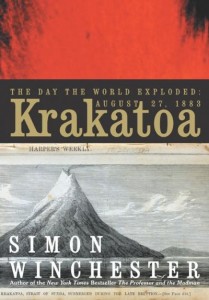 “Should form an essential part of the reading list for every undergraduate geologist” – Joel Gill, GfGD’s National Director, reviews Simon Winchester’s 2003 bestseller Krakatoa: The Day the World Exploded…
“Should form an essential part of the reading list for every undergraduate geologist” – Joel Gill, GfGD’s National Director, reviews Simon Winchester’s 2003 bestseller Krakatoa: The Day the World Exploded…
During a recent break I had the privilege of reading Simon Winchester’s best-selling book Krakatoa: The Day the World Exploded (I know what you’re thinking – ‘nice light-hearted holiday reading’). First published in 2003, this book achieved international success, and as such I’m fairly ashamed that it has taken me a decade since publication to read it. Winchester is the author of a number of other texts such as The Map That Changed the World: A Tale of Rocks, Ruin and Redemption, Atlantic: A Vast Ocean of a Million Stories (The Biography of and Ocean), and A Crack in the Edge of the World: The Great American Earthquake of 1906 – none of which I have read, but all of which I ordered minutes after arriving home.
In his book, Winchester expertly guides the reader through the extensive background required to understand the nature and magnitude of the 1883 Krakatoa eruption and its impact on society (both in the region and globally) at the time. He brings together strands of history, religion, biology, social and cultural understanding (mixing well established ideas with ones that are less convincing, but worth investigating), as well as the essential earth science that you would expect from a book about Krakatoa and a volcanic disaster. A great strength of this book is its ability to effectively integrate multiple disciplines. This multifaceted discussion allows an in-depth understanding of the story of the 1883 eruption, as well as critical consideration of possible preceding and future eruptions. Throughout this book Winchester discusses the great historical developments of theories regarding evolution and natural selection, and continental drift and plate tectonics. To some readers these histories of thought and theory may seem long-winded, tangents even. For myself, they brought a completeness and comprehension to the story that I very much enjoyed (both as a geoscientist and with some interest and study experience in the history of science).
This is a book that I’m sure would make many a geologist stop and think (often uncomfortably) about how much time they take to study the history and culture of their field location/case study sites, and the variety of sources used in their work. Winchester utilises a broad array of information about past eruptions (recent and ancient history) – the use of diaries, ship logs, first-hand accounts and other manuscripts is in contrast to much of the hazards training given by earth science departments (even if researchers use these evidence sources within their own research). The research undertaken by Winchester, and subsequent narrative, demonstrates that a critical mind and willingness to delve into some history and social science can make an important contribution to hazards research – just as much (and sometimes more) than the mighty geological hammer. Absolute dating methods can give ages for lava flows and ash deposits between a certain (sometimes wide) range; manuscript descriptions and evidence can give us a much greater level of precision. Yet analysing the veracity of these, understanding the culture in which they were written, even knowing where to find them are skills that would be foreign to many geoscience students.
In his descriptions of the 1883 eruption climax, Winchester manages to convey (far from an easy challenge) the enormity and sheer power of the volcanic eruption, and the chaos and devastation it caused. Having read multiple hazard textbooks and academic papers on historical eruptions I am familiar with the processes and impacts related to volcanic eruptions. Through his descriptive prose, and use of witness testimony, however, Winchester succeeds in doing more than informing, transporting the reader to the region in those catastrophic months. The way in which I read about and imagine large volcanic eruptions and disaster events will certainly be shaped by this experience from now on.
Winchester’s book is in many ways a masterpiece. As a geologist and a researcher of natural hazards (examining both past hazard events, and thinking about future hazard potential) I found it inspiring, informative, and immensely challenging. It is a stark reminder of the importance of having knowledge and sensitivity to place when thinking about disaster events (both past and future, and thus central to disaster risk reduction). If you want to work within natural hazards or disaster risk reduction, this is a must-read book – and one that should form an essential part of the reading list for every undergraduate geologist.
